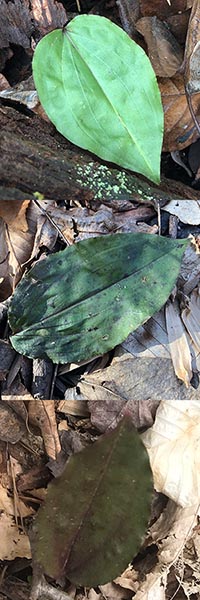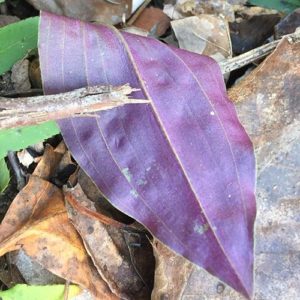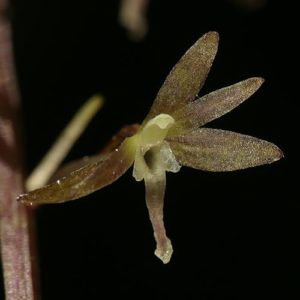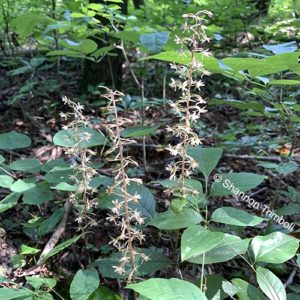Take a walk in the woods in the late winter or early spring and you may find a single, green, oval leaf lying among the fallen tree leaves. I often find single leaves scattered here and there, but you can occasionally find small patches. The leaves are around 3 inches in length and kind of a dull to slightly shiny green on top. They almost look fake to me.

Often the top of the leaf will also have dark purple to blackish spots. The spots remind me of black spot fungal growth, but it’s just the pigmentation of the leaf, not a disease or fungal issue. Some leaves may be completely purplish brown or greenish brown on top, although I don’t see that color morph as often as leaves that are green or green with purple spots. If you flip the leaf over, then it will be a rich purple color.
It would be very easy to overlook such a simple leaf. I did for many years, but not anymore. This is the leaf of a cranefly orchid. The leaf itself may not look like anything special, but now I always make a mental note of where I found it so I can come back in the summer to see if it’ll bloom.
General Biology and Life History of the Cranefly Orchid
The cranefly orchid (Tipularia discolor) is native to most of the eastern U.S. In parts of its range, it is relatively common as far as orchids go. In other parts of its range, the cranefly orchid is considered rare, threatened, or endangered. It tends to be more common in the central part of the eastern U.S. and along the mountain ranges, and less common the further north you go and into the deep south.
Cranefly orchids usually grow in well-draining, moist to semi moist deciduous woods, although in Florida, Georgia, and parts of its southern range it can sometimes be found growing in oak-pine forests. It also likes a slightly acidic soil and lots of humus. Cranefly orchids are often found growing in association with rotting wood.
Relatively little light reaches the forest floor in the middle of the summer, so cranefly orchids take advantage of the lack of winter leaf cover. In the late fall or early winter, each plant will produce a single green leaf. The leaf is called a hibernal leaf because it is present only during the winter when many other plants are dormant.

Although you can start looking for cranefly orchid leaves in the fall, I think it is easiest to find the leaf in the late winter or early spring when the tree leaves from the previous fall have started to decompose and mat down a bit. By late spring, the cranefly orchid leaves will have died back and disappeared completely. The cranefly orchid’s window for photosynthesizing and gathering light closes as the tree canopy fills in with new leaves.
Cranefly orchids bloom within the July to September timeframe. No leaves are present at this time. The plant will send up a single flower stalk which can have up to 40 small beige-ish and light purplish flowers that open in sequential order from the bottom of the stalk up to the top. Cranefly orchids get their name because the flowers supposedly reminded someone of a cranefly. Personally, I don’t see it, but maybe you do.
The flower stalk is only around a foot to a foot and a half tall. Since the color of the flowers isn’t very flashy, they have a tendency to disappear in the dappled light of the forest floor. That’s why locating the leaves in the winter or early spring is so important if you want to find the plant when it is in flower. At least if you know where the leaves were, then you know where to look for the flowers.
Each flower is asymmetrical so most of the flower’s parts are located on either the left or the right. This flower design is odd for orchids because most orchids have flowers that look the same on both the right and left sides. However, this asymmetrical design of the flowers plays a very important role in the flower’s pollination.

Like all orchids (and milkweeds), the cranefly orchid produces pollen in sticky sacks called pollinia. The pollinia allow the pollen for each flower to be moved as a unit or packet, instead of individual grains or pollen being moved like you might see with sunflowers or many of our familiar garden plants.
It takes a lot of energy for cranefly orchids to reproduce, and there is only so much energy that they can gather and store during the winter. If a plant blooms this year, then it may not bloom next year. Pollinated flowers will produce seeds. Cranefly orchids can also spread vegetatively by forming a chain of corms (small bulb-like structures).
Pollinator and Wildlife Uses
Cranefly orchids are pollinated by the armyworm moth (Mythimna unipuncta) and perhaps a couple of other species in the Noctuidae family of moths. The moths are drawn to the flowers for the nectar which the cranefly orchids produce in their nectar spurs. (The nectar spur is that long pointy thing that sticks out behind the petals.)
As the armyworm moth forages for nectar deep in the nectar spur, either the moth’s right or left eye, depending on the direction of the flower, may come into contact with the flower’s pollinia. If the moth’s eye touches the pollinia, the pollinia sticks to the eye. The pollinia will stay on the moth’s eye until it is transferred to another flower or in some way brushed off.
In addition to providing nectar for the armyworm moth and potentially other moth species, deer will eat the cranefly orchid leaves and small mammals have been documented eating the corms.

Incorporating Cranefly Orchids into Your Yard
Cranefly orchids are picky about their soils. They require associations with specific fungal and other soil microorganism in order to live. If your property includes deciduous woods and you are within the cranefly orchid’s range, then you may have it growing naturally on your property and can enjoy them there. However, this is one native wildflower that I don’t recommend people try to plant. It’s just so picky and its fungal associations are so critical that your odds of being able to successfully move it to a new location are relatively low.
At least in part because it is so picky, most native plant nurseries that I am aware of do not grow cranefly orchids. It also does not germinate well from seed. If you can find someone that sells it, you will most likely be buying the corm. Corms can be propagated through divisions, which creates clones of the original plant. You want to make sure that the corms you are purchasing were propagated and not dug out of the wild. You will also need to think very carefully about where you are going to plant it and how you will make sure it has all of the conditions it needs to grow if you want it to survive.
Please tell your friends about Backyard Ecology.
(Social media sharing buttons can be found below the footer.)

Backyard Ecology: Exploring Nature in Your Backyard
Nature isn’t just “out there.” It’s all around us, including right outside our doors. Hi, my name is Shannon Trimboli, and I am the host of Backyard Ecology. I live in southcentral Kentucky and am a wildlife biologist, educator, author, beekeeper, and owner of a nursery specializing in plants for pollinators and wildlife conservation. I invite you to join me as we ignite our curiosity and natural wonder, explore our yards and communities, and improve our local pollinator and wildlife habitat. Learn more or subscribe to my email list at www.backyardecology.net.

Leave a Reply to Deborah Rosenthal Cancel reply